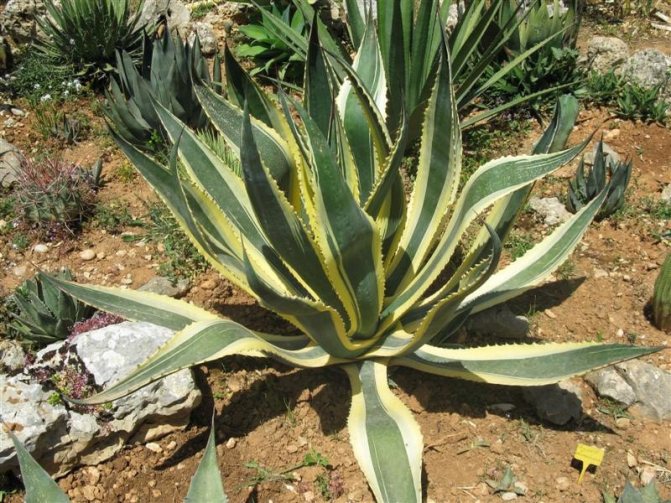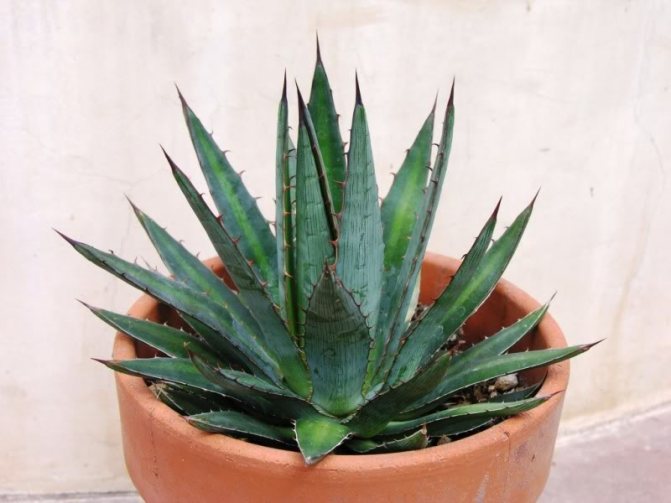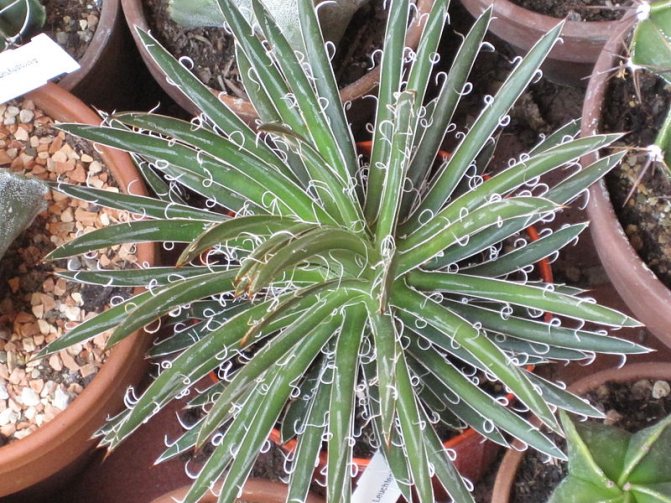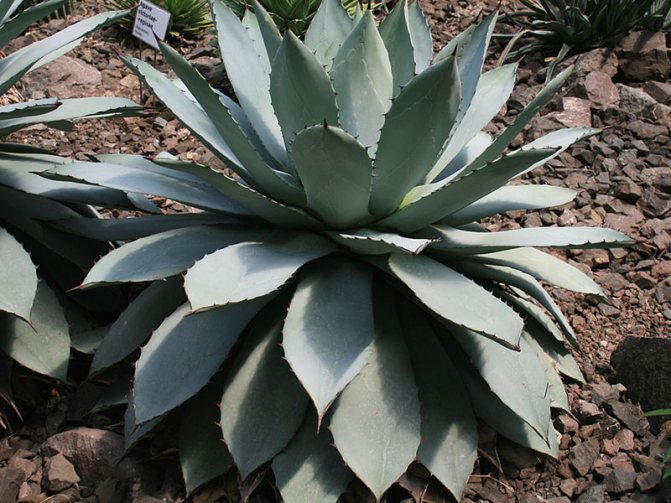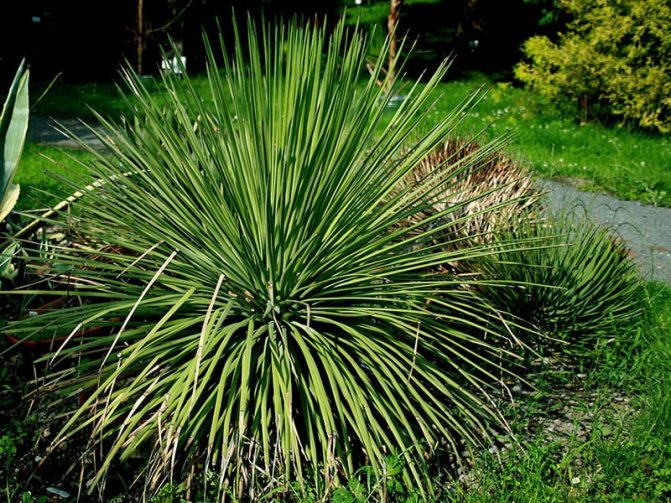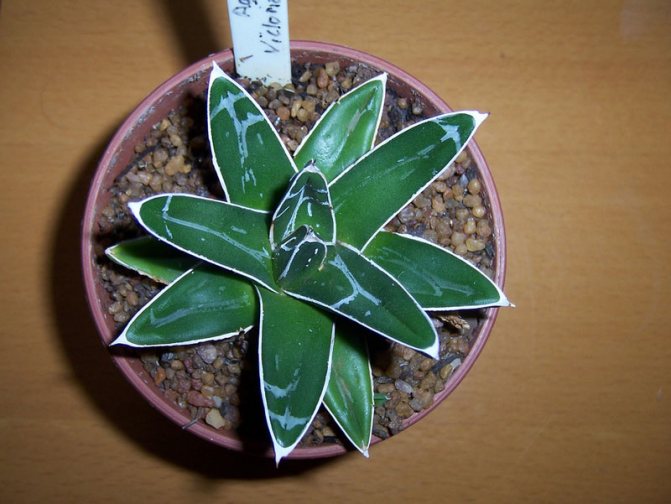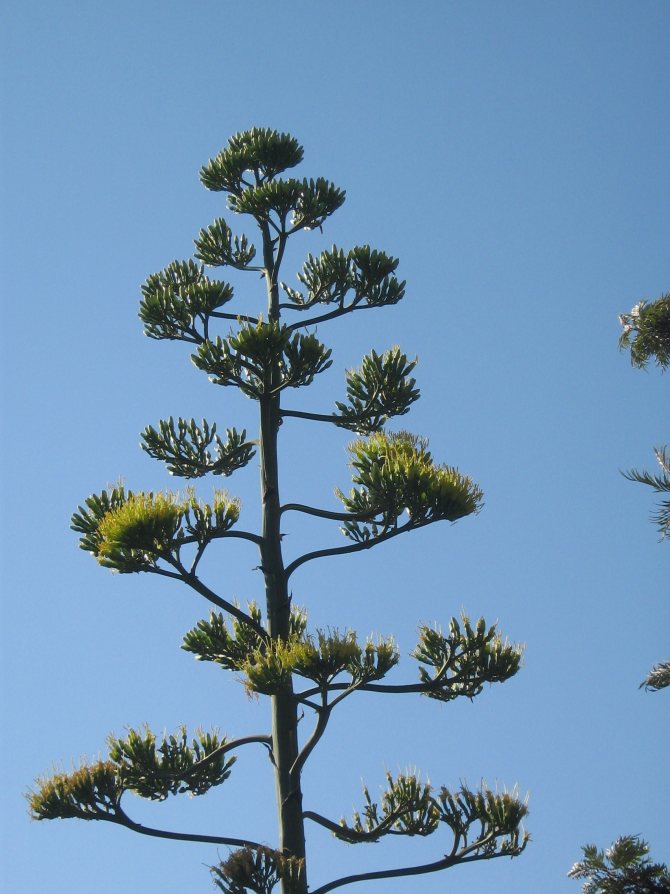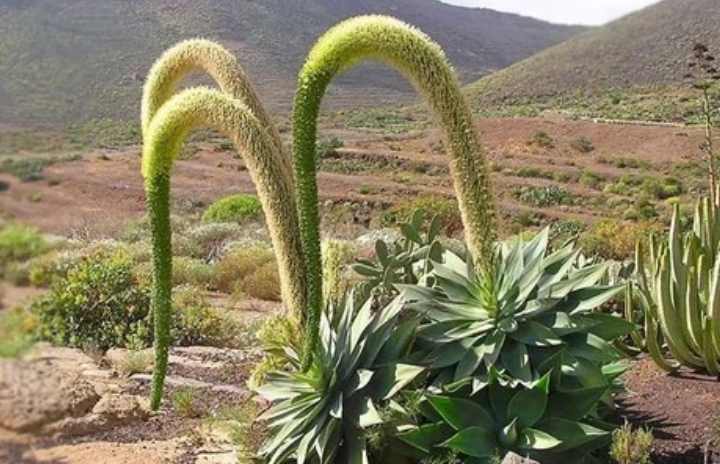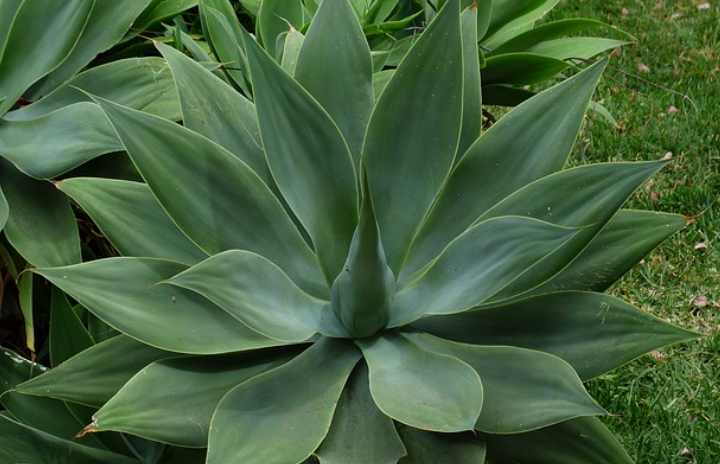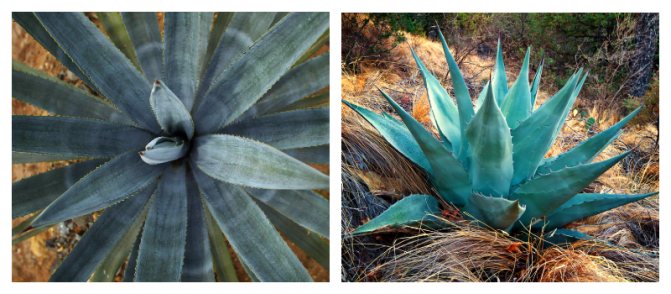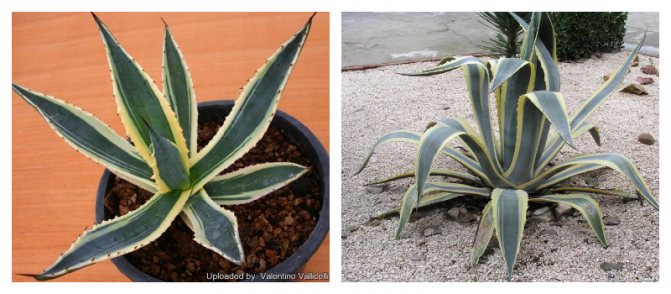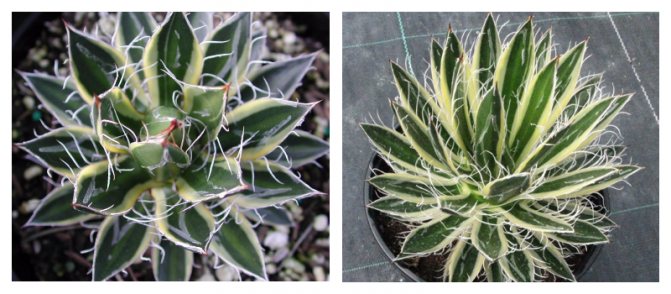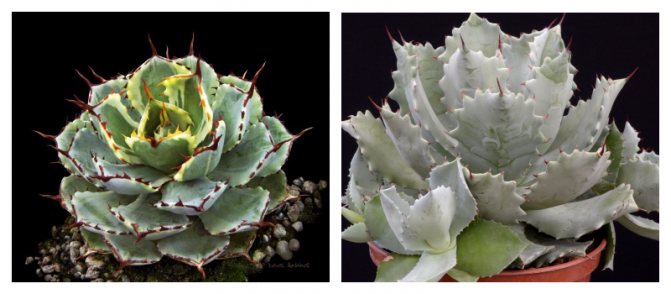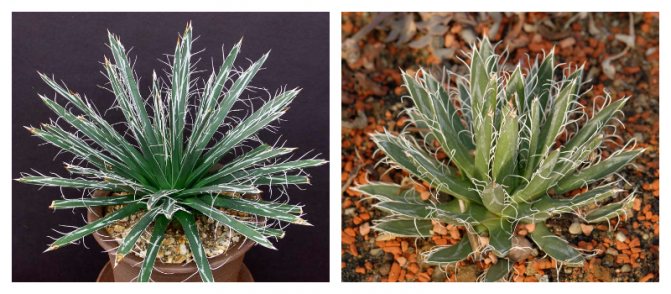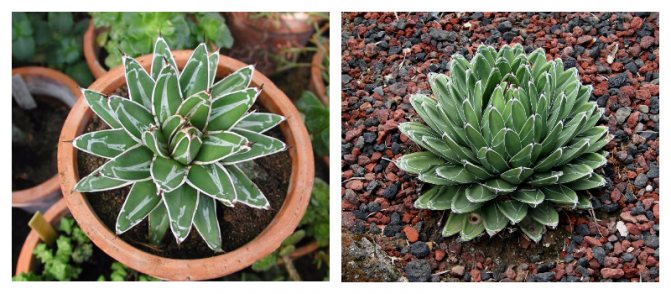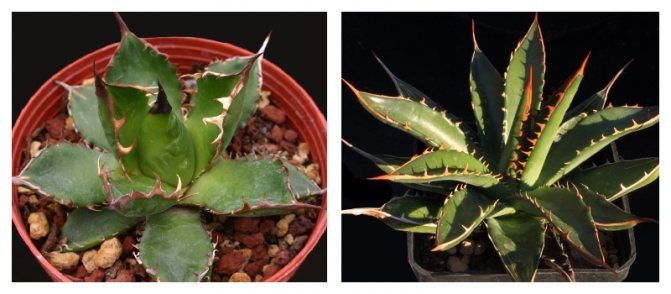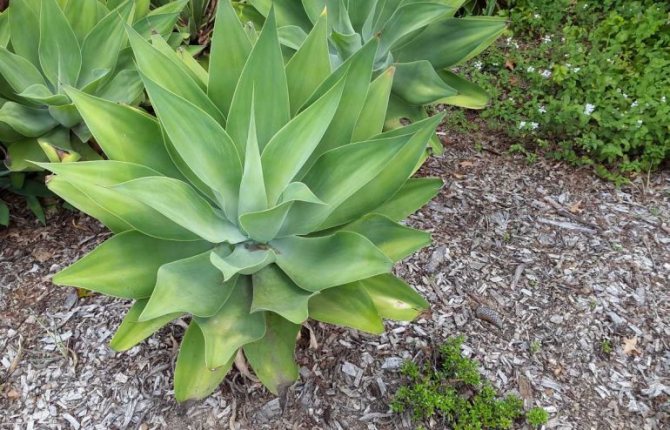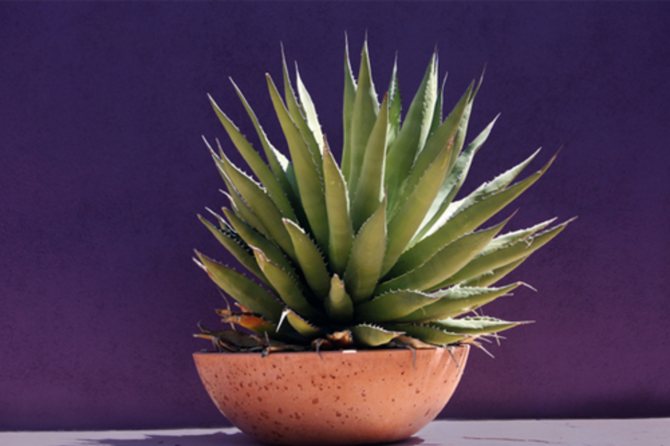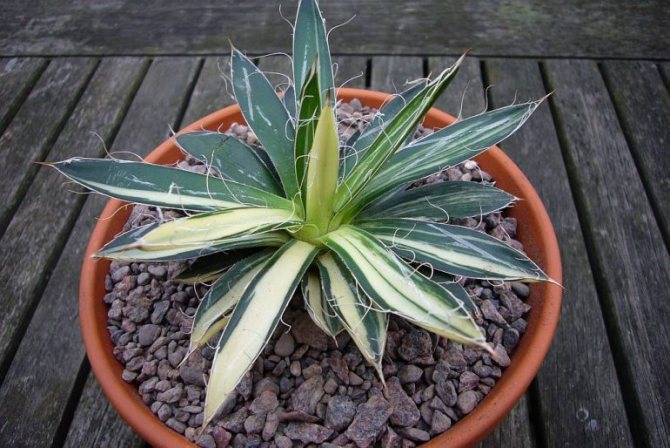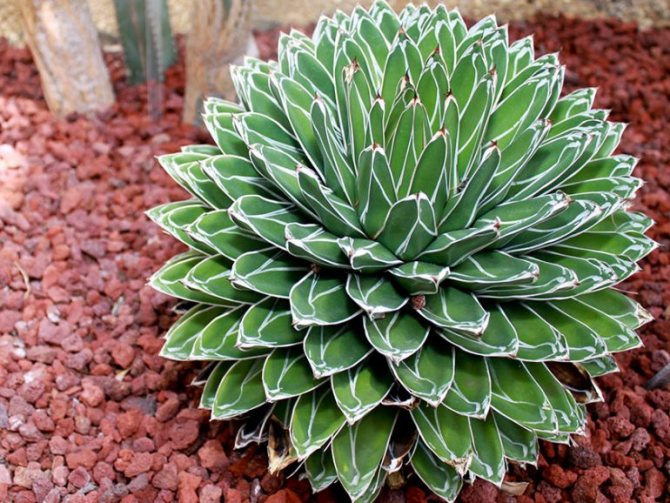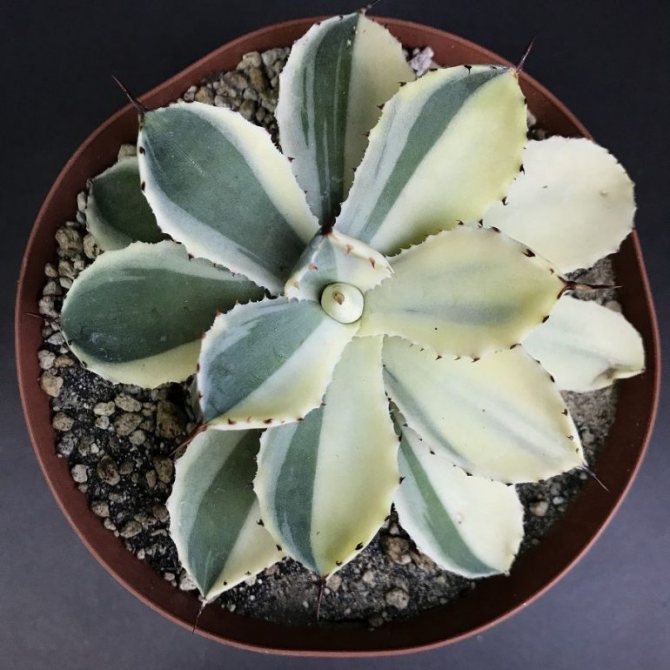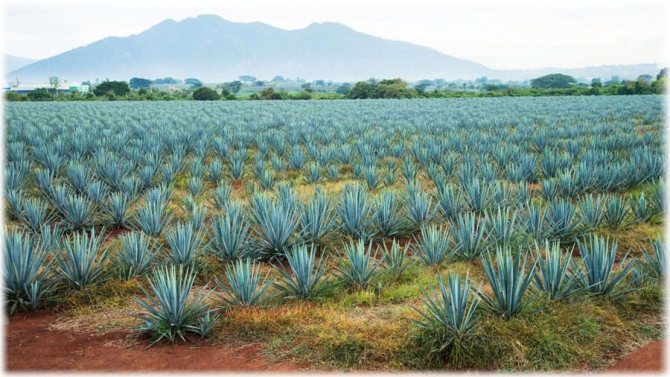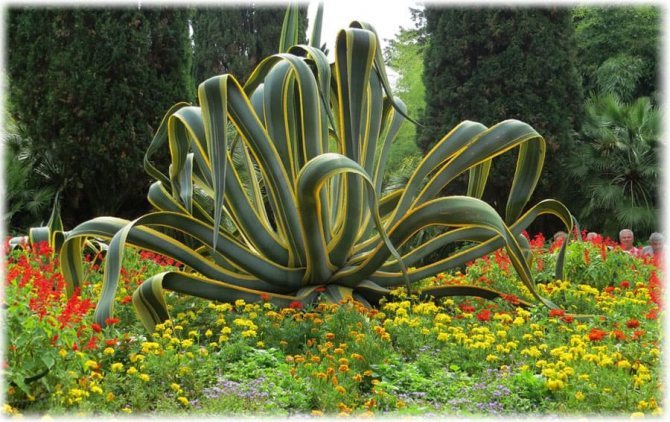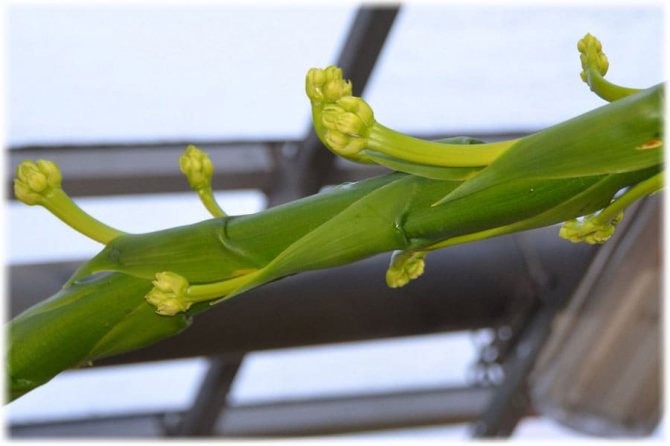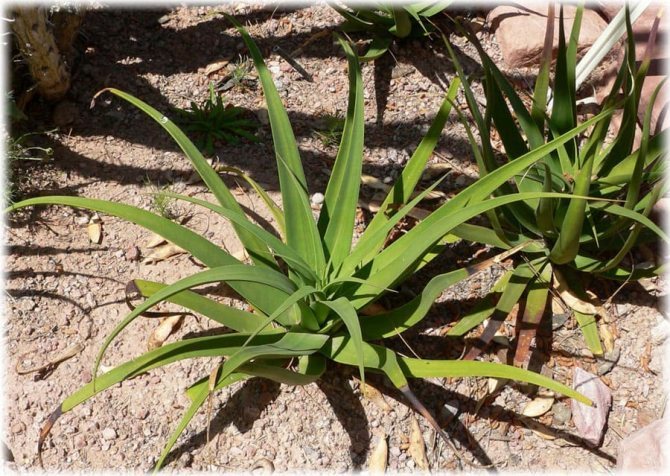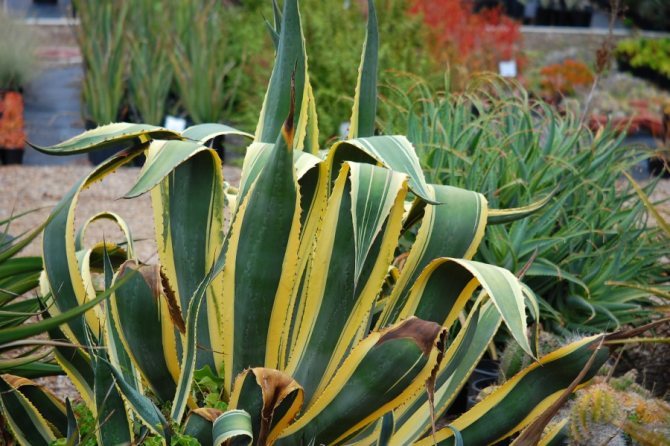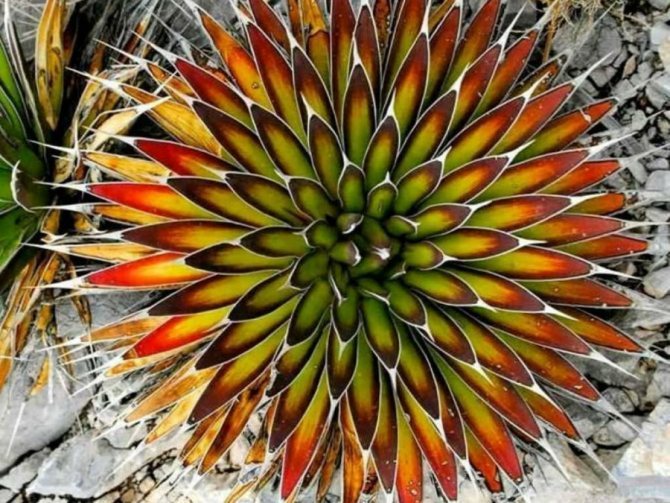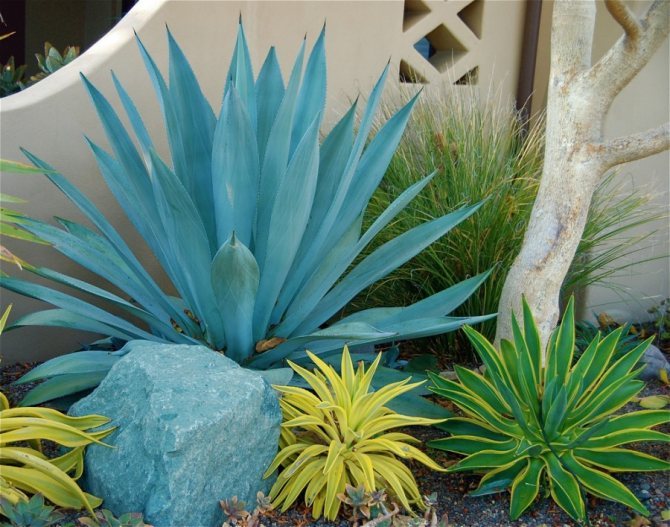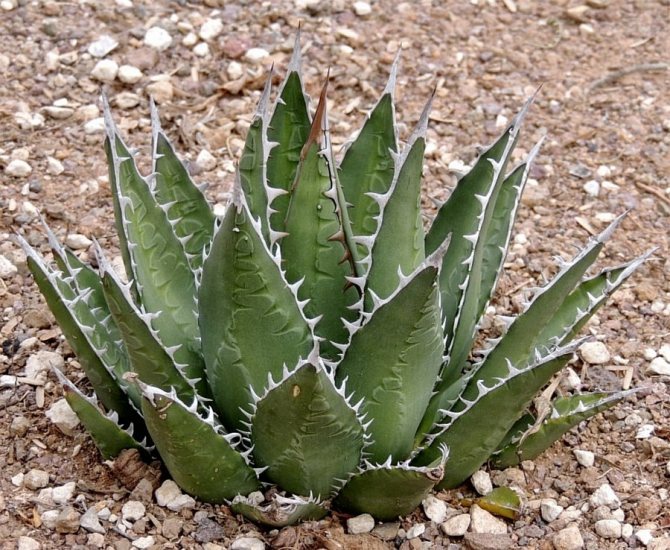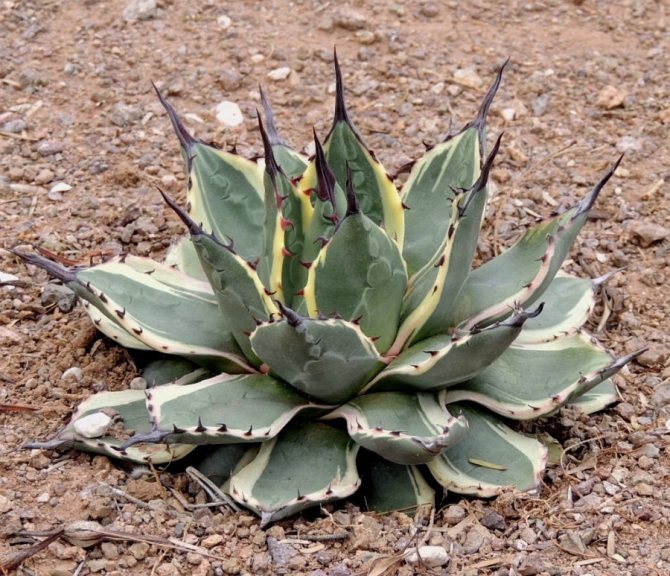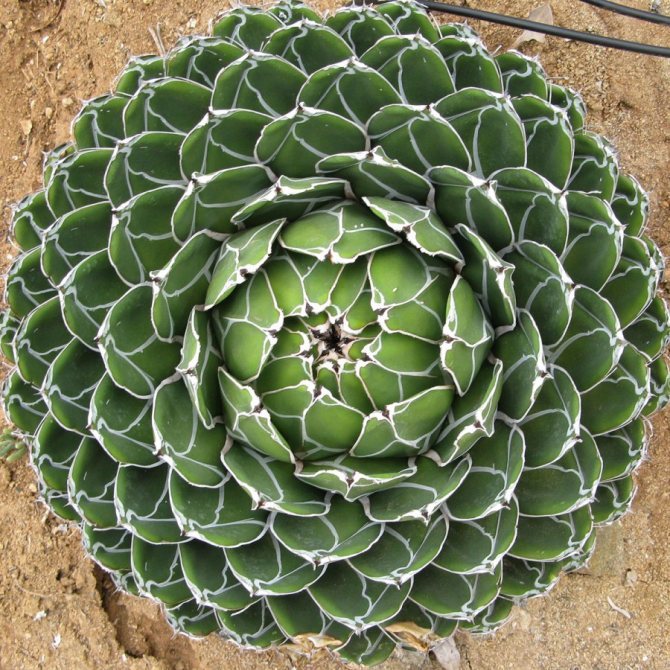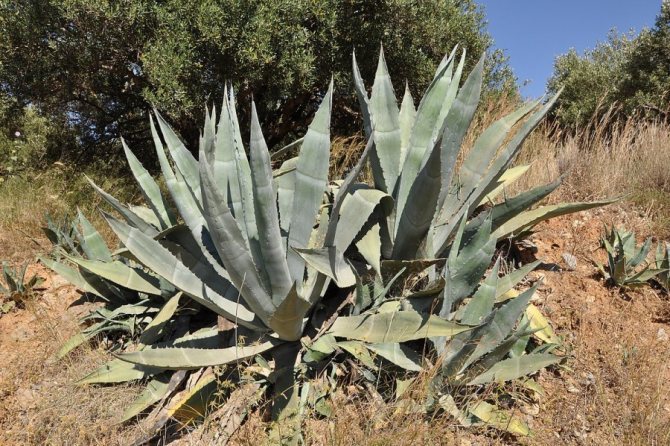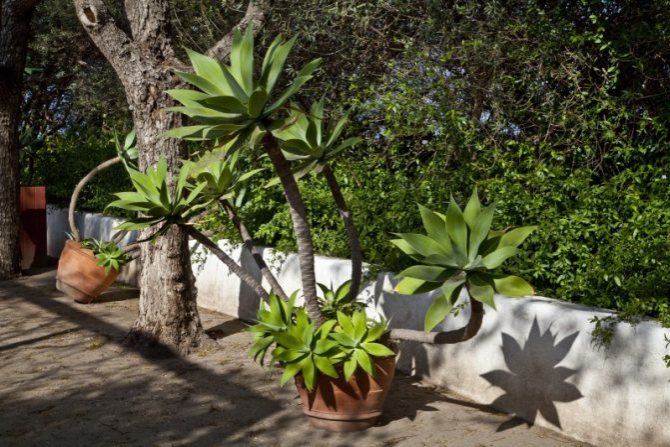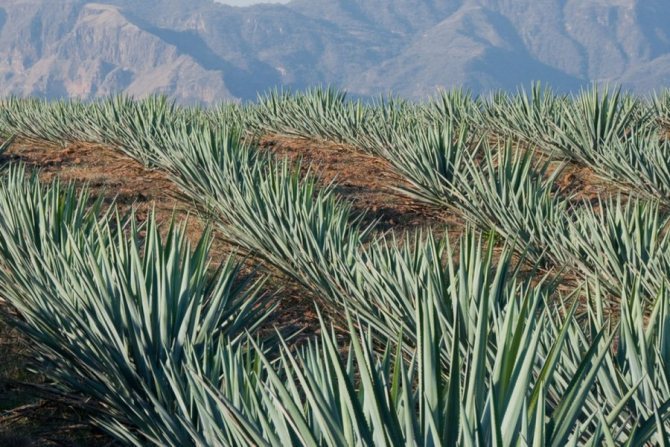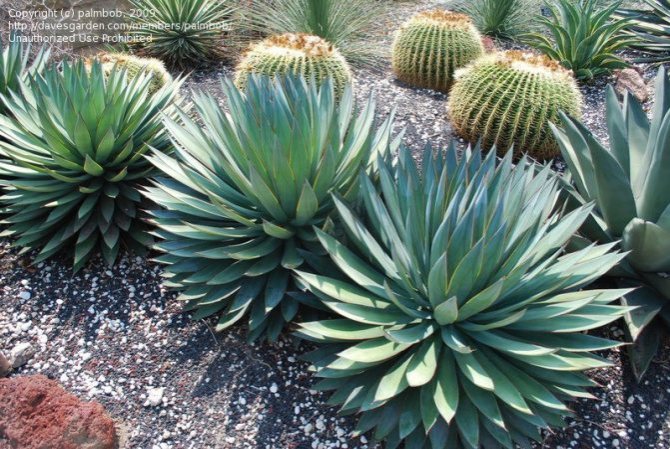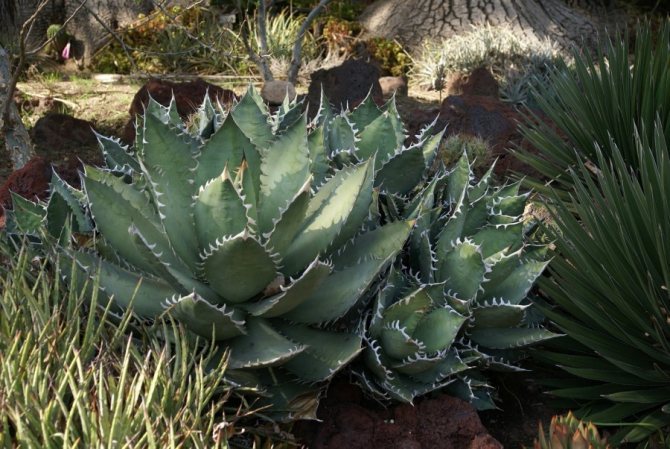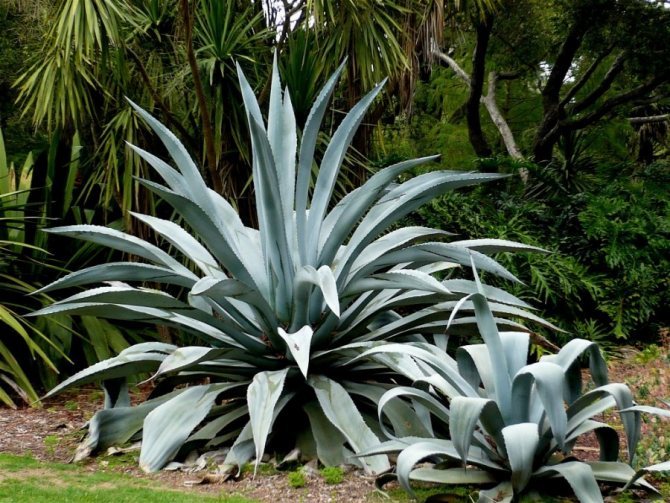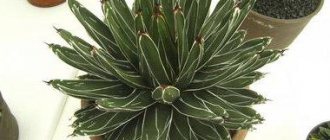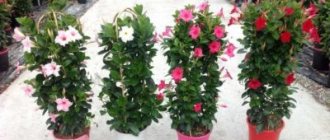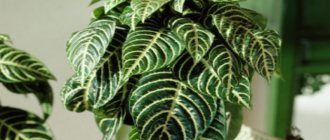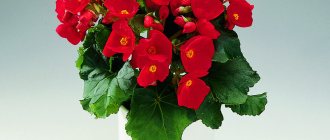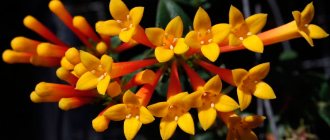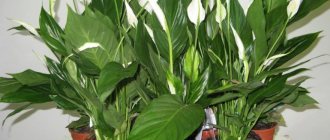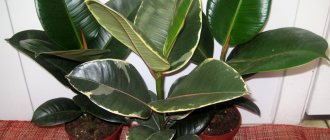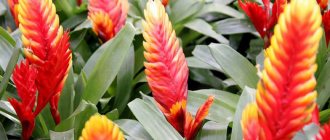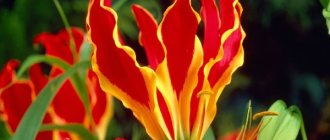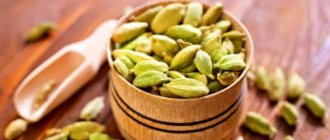Agave (Agava) genus consisting of monocotyledonous plants belonging to the subfamily of the same name Agavoideae, ranked in the Asparagaceae family. The subfamily includes about 700 currently known species, 200 of which are found only in the United States (from the states of Utah and Nevada, ending with the lands of the West Indies and northern regions of South America). There, plants grow successfully on coastal lands, practically in areas that reach the surf, but they can settle in mountainous areas at an absolute height of up to 3000 meters. But still, the homeland of this wonderful plant is considered to be the territory of Mexico and the surrounding areas. In European countries, agave appeared only after the American continent was discovered and the most widespread variety of American agave (Agava americana), it is grown as an ornamental crop in the Mediterranean. On the territory of Russia, this agave variety is grown on the Black Sea coast, the coastal territories of the Caucasus and the southern shores of the Crimea.
The plant bears its name in Latin in honor of the ancient Greek Agave, the third daughter of King Cadmus. This word is translated as wonderful, noble and excellent. However, the fate of this woman was very tragic. She and her son Pentheus did not want to believe in the divine origin of Dionysus (the god who patronized winemaking, the fruitful forces of the earth). For this, Agave was punished, she, participating in the procession and dances of the bacchantes (maenads), was completely distraught and, together with her sisters Autonia and Ino, tore her own son Penfey to pieces. And then, taking his head, she brought it to King Cadmus, her father, still in a mad state, mistaking it for a lion's head. These are the sad things that happened in antiquity!
The stem of the agave is very shortened, and at its base it is presented in the form of a leaf rosette, into which long, often fleshy and spiny leaf plates gather. The rosette diameter is highly dependent on the plant species. Its size can start at 3–4 cm (eg Agava pumila) and go up to 4.5 m (represented by Agava franzosini). The number of leaves is also very variable, but usually there are 20-50 units per rosette, and in some species this number can go up to 200 pieces. The length of the leaf plates also directly depends on the species - it can be either a baby with a leaf length of 10-12 cm, or a giant with indicators up to 3 meters.
Their shape is quite varied, casting can be very wide or rather narrow, rounded or with a pointed top, upright and drooping over time to the ground. Their color is also very diverse: from light greenish to bluish-green, with a brown serration, which is present on the edge of the cast. And also with drawn longitudinal stripes or creamy-whitish spotting. Some species are devoid of teeth at the edge of the leaf and have a rough surface, they can be covered with a thick coating like wax.
The peduncle, which is pulled out from the center of the rosette, can reach up to 12 m in some agave varieties. At the top of this flower stem, there are a large number of inflorescences (their number can reach up to 17 pieces), in which yellowish or greenish flowers gather. The shape of the inflorescence can be spike or paniculate. On the peduncle, so-called bulbinella often appear from the adventitious buds - small daughter plants, tiny agave plants with leaves and root processes. They eventually fall to the ground, where they take root, growing into large specimens. After the end of flowering and ripening of the fruit, the entire aerial part of the plant will die off.In fact, agave is a monocarpic representative of the flora, that is, it blooms once in its life. Some species bloom at the age of 5-15 years, but there are those that will release their peduncles, being at the age of 50 and even 100 years of age.
The fruit is a capsule consisting of intergrown carpels. Growing this exotic plant is completely easy, and even a novice florist can handle it.
Description of agave
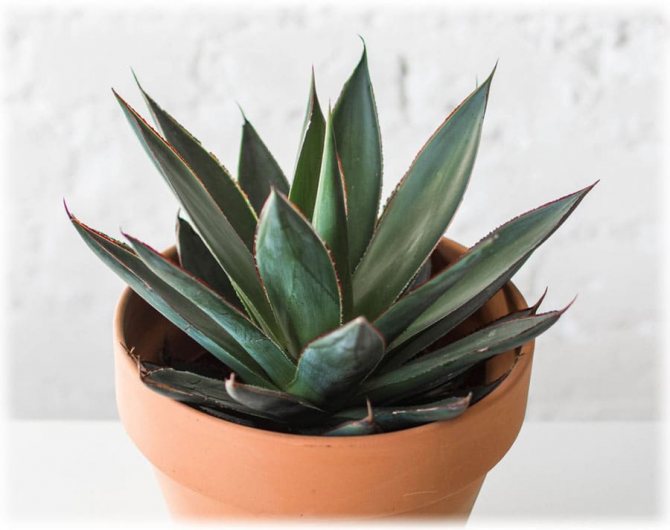
Most species have straight or curved thorns along the edges of the leaves. Small, slow-growing agaves are used at home as pot plants. The leaves are green, bluish-green, or gray in color; some varieties have leaves with white or yellow stripes.
In indoor conditions, they do not bloom often, the inflorescence may appear after 10 years, after which the plant itself dies and leaves behind root suckers in large quantities.
Taxonomy
| ||||||||||
| American agave (Agave americana ). | ||||||||||
List of the most famous species [6]:
- Agave acklinicola Trel.
- Agave americana - American agave
- Agave angustiarum Trel. ex Standl.
- Agave angustifolia Haw.
- Agave applanata K.Koch
- Agave asperrima jacobi
- Agave atrovirens Karw. ex Salm-Dyck
- Agave attenuata Salm-Dyck - Agave Drawn
- Agave aurea brandegee
- Agave avellanidens Trel.
- Agave bahamana Trel.
- Agave bovicornuta Gentry
- Agave bracteosa S. Watson ex Engelm. - Bracts agave
- Agave brevispina Trel.
- Agave cantula Roxb.
- Agave celsii Hook.
- Agave cerulata Trel.
- Agave chiapensis Jacobi
- Agave chrysantha peebles
- Agave chrysoglossa I. M. Johnst.
- Agave colimana gentry
- Agave colorata Gentry - Agave colored
- Agave dasyliriodes Jacobi & C.D.Bouché
- Agave datylio F.A.C. Weber
- Agave deserti Engelm.
- Agave eggersiana Trel.
- Agave ellemeetiana Jacobi
- Agave filifera Salm-Dyck - Thread agave
- Agave flexispina Trel. ex Standl.
- Agave fourcroydes Lem. - Agave furcroid, or Heneken, or Geneken
- Agave franzosinii baker
- Agave funkiana K.Koch & C.D.Bouché - Agave Funka
- Agave geminiflora (Tagl.) Ker Gawl.
- Agave ghiesbreghtii K. Koch
- Agave gracilipes Trel.
- Agave guiengola Gentry
- Agave harrisii Trel.
- Agave havardiana Trel.
- Agave hookeri jacobi
- Agave horrida Lem. ex Jacobi
- Agave indagatorum Trel.
- Agave karwinskii Zucc.
- Agave kerchovei Lem.
- Agave kewensis Jacobi
- Agave lechuguilla Torr.
- Agave lophantha schiede
- Agave lurida aiton
- Agave macroacantha Zucc. - Wide-bordered agave
- Agave mapisaga Trel.
- Agave margaritae brandegee
- Agave marmorata Roezl
- Agave murpheyi F. Gibson
- Agave oblongata Jacobi
- Agave obscura schiede
- Agave ousselghemiana Jacobi
- Agave palmeri Engelm.
- Agave pampaniniana A. Berger
- Agave parrasana A. Berger - Parras agave
- Agave parryi Engelm. - Agave Parra
- Agave parviflora Torr.
- Agave pedunculifera Trel. ex Standl.
- Agave pendula Schnittsp.
- Agave polyacantha Haw.
- Agave potatorum Zucc. - Potato agave
- Agave promontorii Trel.
- Agave rigida Mill.
- Agave salmiana Otto ex Salm-Dyck
- Agave schidigera Lem.
- Agave schottii Engelm.
- Agave sebastiana greene
- Agave seemanniana Jacobi
- Agave shawii Engelm.
- Agave shrevei gentry
- Agave sisalana Perrine - Sisal Agave, or Sisal
- Agave sobolifera Salm-Dyck
- Agave sobria Brandegee
- Agave striata Zucc.
- Agave stricta Solm. - Agave straight
- Agave tequilana F.A.C. Weber - Blue Agave, or Tequila Agave
- Agave terraccianoi Pax.
- Agave toumeyana Trel. ex Standl. - Agave Tumi
- Agave utahensis Engelm.
- Agave victoriae-reginae T. Moore - Queen Victoria's Agave
- Agave vilmoriniana A. Berger - Agave Vilmorena
- Agave vivipara - Agave viviparous
- Agave wercklei F.A.C. Weber ex Wercklé
- Agave wocomahi gentry
- Agave xylonacantha Salm-Dyck
Hybrids
- Agave × glomeruliflora (Engelm.) A. Berger [= Agave lechuguilla × Agave havardiana?]
- Agave × arizonica Gentry & J.H. Weber [= Agave chrysantha × Agave toumeyana]
Reproduction methods
Agave propagates in two ways - by seeds and shoots. The first option is quite laborious and long-developing seedlings will not soon give a full-fledged beautiful outlet. At home, it is much more practical and faster to get a young plant from a near-stem offspring. To do this, the shoot is carefully separated from the plant, left in the air for 3-4 hours, so that a transparent crust forms on the wound. Then the place of the cut is powdered with wood ash and fixed with pebbles on a slightly damp sandy substrate. Under favorable conditions, the roots appear quite quickly, after which the sockets are transplanted into pots.
Indoor agave, with its decorative appearance, brings exotic notes to the interior both as a single plant and in flower compositions.
The healing properties of the plant
Blue agave is prized for its beneficial effects on the gastrointestinal tract and its ability to fight gastrointestinal pathologies. The extract is used in preparations for the treatment of colitis and Crohn's disease.
Interesting: Medicinal properties and contraindications of oregano, how to apply
Infusions made from agave:
- accelerate the removal of excess fluid;
- reduce intoxication;
- have a diuretic and laxative effect;
- normalize metabolism;
- stimulate metabolic processes.
However, this type of plant is more famous for the famous alcoholic drink produced from its core than for its healing qualities.
Agave species
Agava Americana - American
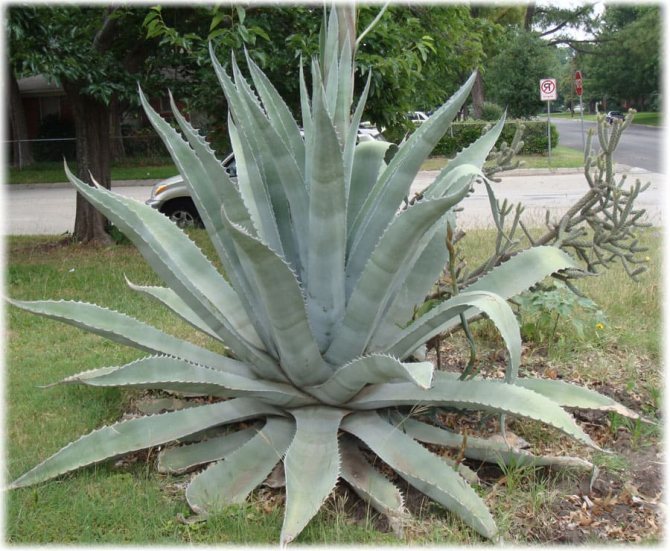

Agava Americana - American. A bushy plant with a shortened stem of 25-30 cm and fleshy large leaves, very prickly and sharp, collected in a basal rosette. The height can be 1-2 meters, while the diameter reaches 3 m. The leaves grow up to 2 m long and about 25 cm wide, have a lance-shaped shape and spiny teeth at the edges.
Agava tequilana - blue agave
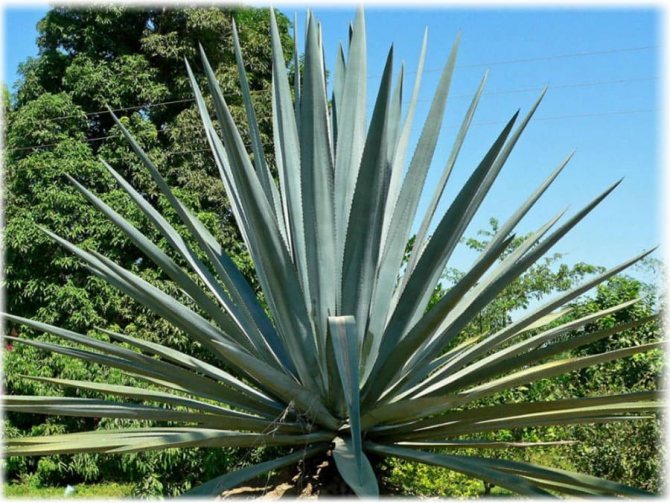

A variety that is widespread in agriculture is the production of tequila (an alcoholic beverage). Blue agave can also be found in the wild, however, in its properties and characteristics, it differs significantly from the house plant.
Agava Filifera - thread carrier
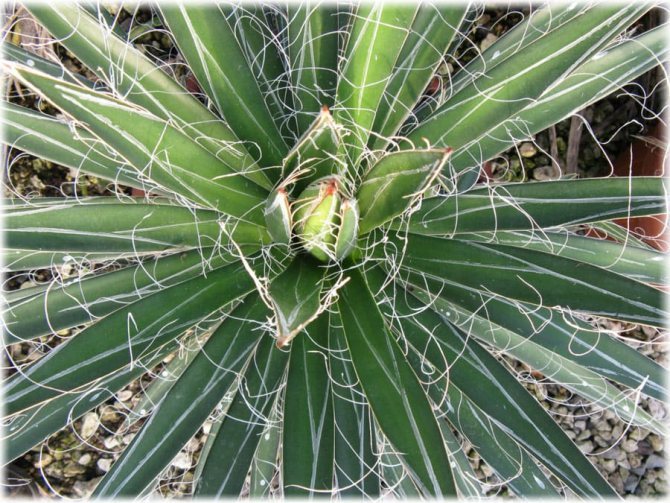

It has leaves more than 20 cm long, which end in a brown spine, matte green with white narrow stripes on both sides. The main feature of this species is that all leaves have dry fibers at the edges.
Agava Potatorum - Potatorum


The leaves are obovate, spatulate, gray-green in color, 9-11 cm wide and up to 30 centimeters long, at the end of the leaves there is a thorn of dark red, or almost black color. The edges are slightly notched with spines of the same color. The homeland of the presented species is Central America.
Agava toumeyana - tumi
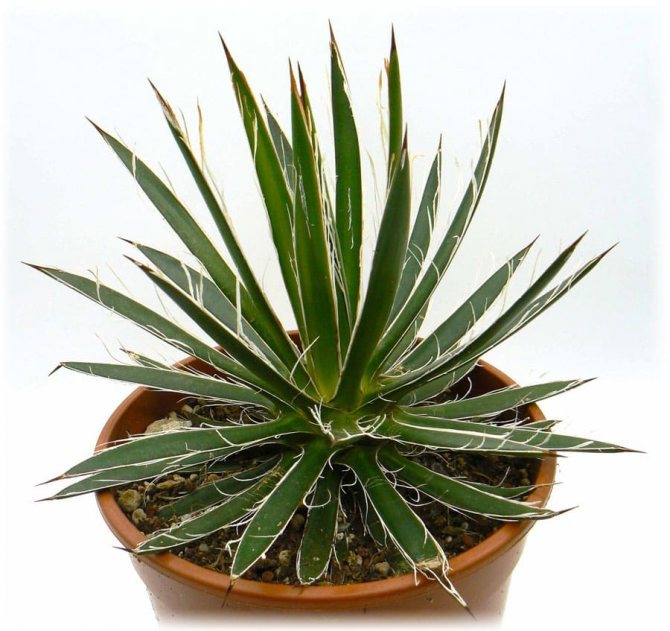

It is a herbaceous perennial plant that forms turf. The leaves have a rosette with a diameter of 30-80 cm. The shape of the leaves is lanceolate, 15-25 cm long and 10-25 cm wide. The color is pale green with white stripes, at the tip there is a thorn up to 8 mm in length. Homeland - USA.
Victoriae reginae - Queen Victoria's agave
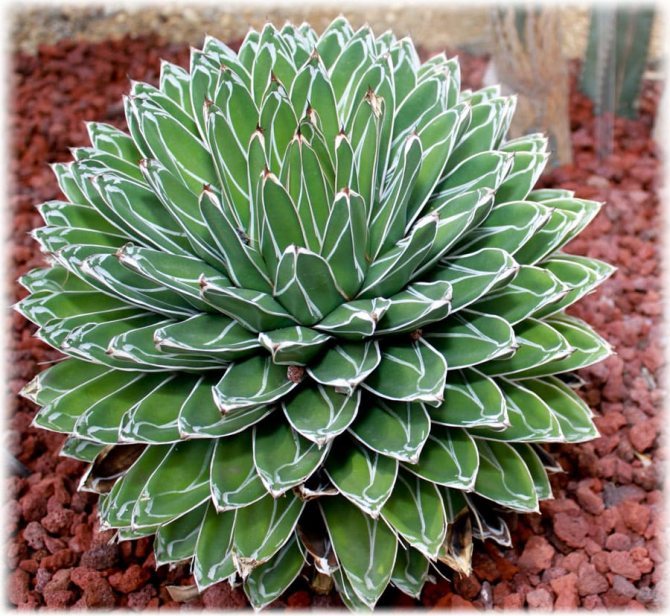

This type is recommended for indoor cultivation. The leaves have a rosette up to 0.6 m in diameter. The length of the leaves can reach 10-15, and the width is 5-7 cm, the color is dark green, with oblique white lines on both sides of the leaf. At the end there is one black spine up to 2 cm in length and several shorter ones.
Agava horrida - scary
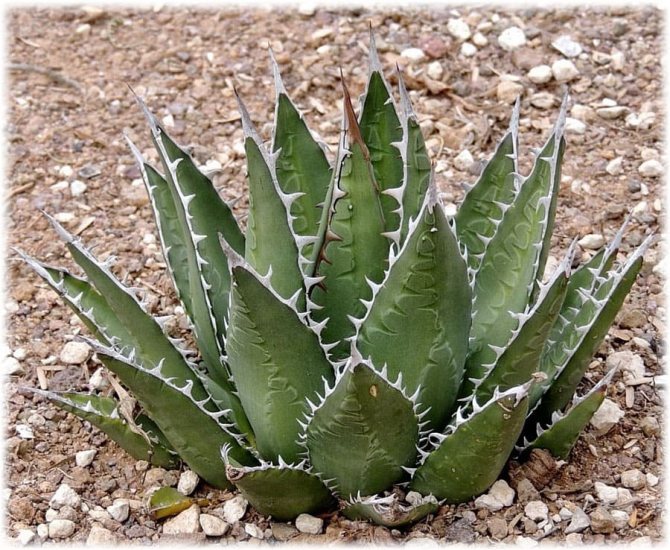

General information
In its natural environment, evergreen agave can be found exclusively in Mexico and Central America. But due to the splendor and a number of medicinal ingredients, it was scattered by man all over the planet, even in northern latitudes.
In the middle of the sixteenth century, Europe learned about this plant. Agave is mentioned in the works of P. Martyr, dated 1533.
To date, in the Mediterranean states, the cultivation of American agave has been established solely for the purpose of decorating streets and squares, beautiful photos of the location are obtained from tourists. In the Russian Federation, it is found in park areas in the south of Crimea and on the Black Sea coast of the Caucasus.
Botanical information
Agaves are perennial succulents with a very shortened lignified stem, about 30-50 cm tall. Only a few in nature form trunks 1–4 m high.
The leaves in most species are fleshy, leathery, sessile, collected in a basal rosette, which, depending on the species, reaches a circumference of 3-4 cm to 4.5 m. The number of leaf blades in the rosette also varies and most have 20-50. but in some species it grows up to 200 pieces. The edges of the leaves of many agaves are studded with powerful sharp spines, light or cherry-red to black.
Mostly all agaves are monocarpics, that is, such plants that, after the only flowering in their life, die off, leaving behind daughter rosettes. Under natural conditions, some bloom for the first time in 5-15 years, others - in 50 or even 100 years.
In some species, the peduncle resembles a real tree up to 8–10 m high, on which the so-called bulbillae, miniature daughter plants, are formed from the adventitious buds. Bell-shaped flowers are located on the lateral stalks of the peduncle, 2–8 per inflorescence, painted in yellowish or light green color. One peduncle bears from several hundred to 10-17 thousand flowers. The fruits are long-ripening capsules.
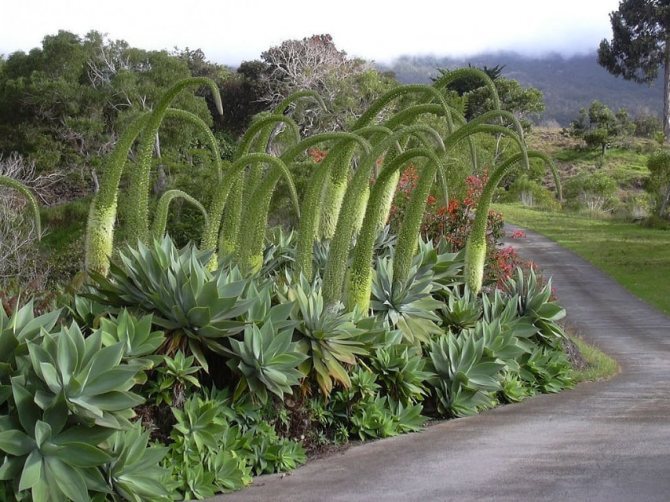

Agave care at home
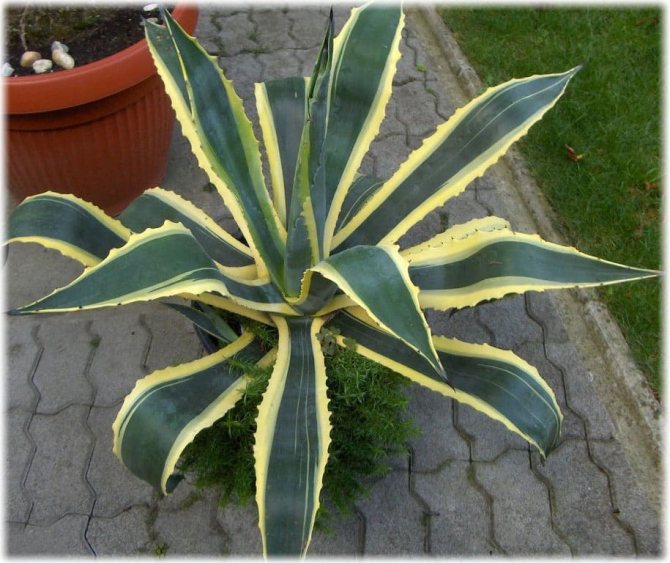

Lighting
Agave, like many succulents, is not afraid of sunlight, so direct sunlight will not harm you. It will grow beautifully on east-south and south windows.
Watering
During the active growing season, the plant requires moderate watering, that is, no more than 2 times every 7 days, so that the earthy clod dries out between waterings.
In cold weather it is watered 1-2 times a month. Needs good drainage so that moisture does not stagnate. It is important that there is no water in the center of the outlet!
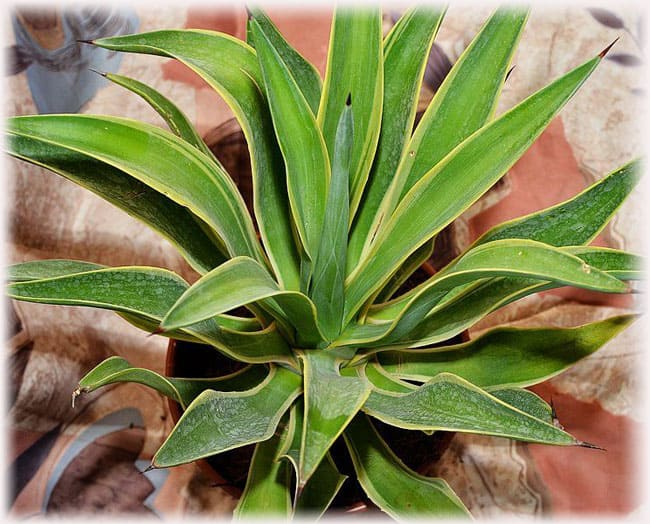

Temperature
In the summer, in the room where the agave grows, the temperature should not be lower than 18 degrees. The optimal range in summer is considered to be 20-28 ° C. However, it is worth noting that the plant can tolerate higher temperatures. On days when the weather is warm outside, you can take it outside or land it in the ground. In winter and cool periods, the temperature should not fall below 10 ° C.
Soil and moisture
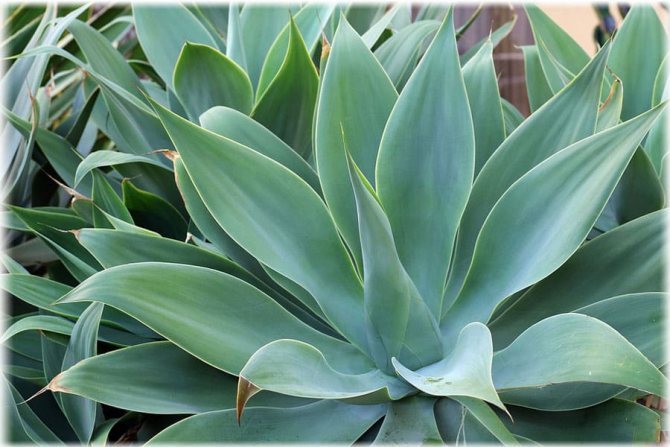

Specificity of care
Agave gets used to the lack of light, for its excess it needs to be prepared. In particular, this applies to young animals. The correct choice of place will correct the condition. In winter, it is advisable to place succulents in a cool, bright room, reduce watering. Comfortable temperature range - from four to ten degrees.
It is possible to extend daylight hours up to sixteen hours. Top dressing is best done in the summer once every three weeks with suitable mineral complexes.
Agave is widely known in Mexico and is suitable for human consumption. By processing the plant, ropes and different fabrics are obtained. The pulp of leaf plates is used in soap making. The medicinal properties of agave juice are known for their laxative and diuretic properties. Agave leaves are applied for bruises and to eliminate bruises. Good repellent.
Breeding features
The easiest way to propagate an agave is to transplant the offspring while transplanting the plant into a new pot. You can also use pieces of rhizomes with 2-3 buds. All cuts and injuries on young shoots are sprinkled with crushed coal, slightly dried to prevent rotting.
It is advisable to plant young plants in sandy soil until they take root. Watering the agave should be very careful.
Another way to propagate agave is by seed, is used extremely rarely and only by those who can get seeds from plants growing in nature. They need to be sown in early March in spacious containers under glass. At a temperature of 20 to 25 degrees, seedlings appear within a week. You can transplant them into separate containers in a month.
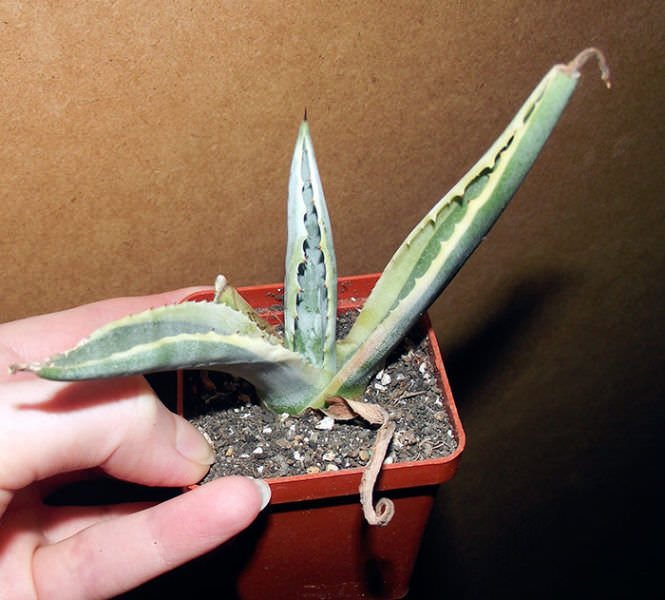

Planting and transplanting
Agave purchased from a flower shop should be transplanted, but not immediately. Give her 2-3 days to acclimatize. Then they pick up a shallow pot with drainage holes at the bottom (preferably ceramic) and prepare the ground. You can buy a ready-made substrate for succulents and cacti, or mix it yourself. The main condition for the soil is good air and moisture permeability, a neutral environment.
The components for the soil mixture are taken in equal proportions:
- leaf compost;
- garden land;
- river sand.
A drainage layer (2–2.5 cm) of expanded clay, brick chips or fine gravel is poured into the bottom of the planting tank. It is not superfluous to add a handful of sand, which will serve as protection against root rot. When planting, the root collar is left open. After completing the procedure, the earth is not strongly compacted. And for stability, the sockets are lined with stones at the base. This will additionally protect the plant roots from sudden temperature jumps.
The first few days after transplanting, the agave should not be disturbed once again, it is worthwhile to water and feed it moderately. This is necessary for the plant to get used to a new place.
In the future, the agave is transplanted as the root system grows, when the old pot becomes cramped. This is usually done every year until the age of five, then every 3-4 years. The procedure is carried out in the spring.
Video on transplanting a flower into a suitable pot
Agave photo
Reproduction
Seed propagation is carried out in February-March, planting seeds to a depth of no more than 1 cm, placing crops in a room with an air temperature of 20-25 ° C. After a week, seedlings will appear, characterized by slow and uneven growth of leaves.
Vegetative propagation is carried out using root suckers growing at the base of the trunk. They are separated together with a part of the rhizome, making sure that there is one node on each separated area. The separated parts are dried for 2-3 hours. The slices are sprinkled with charcoal and rooted in the sand. The container is placed in a warm (about 20 ° C) place.
Rooted plants are planted in separate pots filled with turf and leafy soil and sand, taken in equal parts. The first watering is carried out for 2 or 3 days.
Diseases, pest infestation and methods of dealing with them
Their appearance provokes dust and dirt deposited on the surface of the leaves. The most dangerous for agaves are scale insects, thrips and fungi. Their appearance is indicated by a change in color and the formation of stripes on the leaves.
Pest Control Measures:
- wipe the leaves with a soft cloth dampened with alcohol solution.
- If the lesion is significant and neglected, then water the plant, until the pests are completely destroyed, with the previously diluted Actellik drug, diluting 20 drops in 1 liter of water.
The appearance of fungal diseases is indicated by the presence of gray or brown spots on the leaves. Diseased specimens are treated with fungicides containing copper.
Recommendations for self-propagation of agave
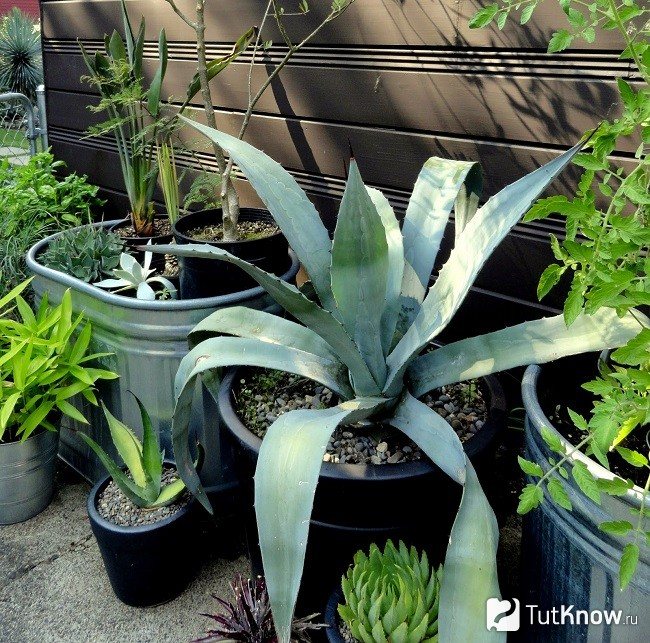

You can get a new exotic plant by sowing seeds, planting offspring, cutting rhizomes.
Naturally, the easiest way to get an agave is by collecting and planting bulbinella in separate containers - small ripened agaves, they are the offspring of the mother plant. The soil is taken the same in which the adult specimen is grown.
The cuttings of the rhizome must be divided in such a way that each of the cuttings has at least one bud. The pieces are left to dry (wither) for 2-3 hours to dry the juice. You can powder the cut with powdered activated charcoal or charcoal. After the specified time, the agave cuttings are planted in a seedling box filled with river sand for rooting. During the first year of vegetation, 4–5 leaf blades can form on young plants, the next - up to 7–9, in another year their number will be 10–12 units.
Seed material that was collected in natural conditions must be sown in February or March. In this case, the depth of the ground does not exceed 1 cm. The substrate in which the seeds are placed must be sandy or sandy-peat. Germination is waited for when the heat is equal to 20-25 degrees and usually they hatch after a week. After the seedlings grow up, you will need to dive - transplant into pots with a diameter of 6 cm. When a year has passed after planting, the container can be changed to a large one (up to 8-9 cm in diameter). The next change of pot and substrate is performed after 2-3 years.
Diseases and pests of agave
If black-brown spots appear on the leaves of your agave, this indicates a fungal attack. The main principle of fighting the disease is special fungicidal preparations that contain copper.
The main pests of the plant are mealybugs and scale insects.
If small lesions are found, the pests are collected, and the plant is washed under running water. With extensive lesions, special drugs are used - karbofos, intavir and others.
At home, you can prepare a medicinal mixture. Make a gruel from soap and garlic by adding a little water. From time to time it is necessary to wipe the agave leaves with a damp cloth.
Air humidity
Agave does not need to be sprayed. It is also not recommended to put a container of water or a humidifier next to the flower.
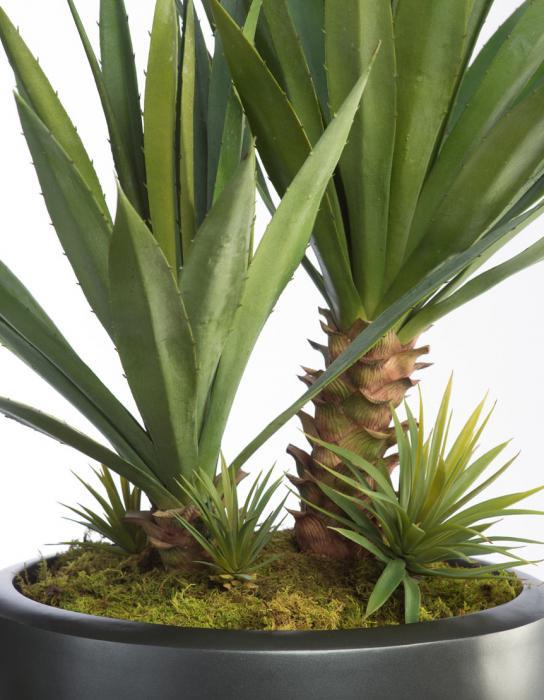

As a rule, apartments have dry air suitable for the plant. If the sockets of the plant are dusty, then they can be wiped with a damp cloth.After this procedure, do not forget to dry them, otherwise rotting and leaves will occur.
General information about agave
Agave (Greek Agauos - noble) is a perennial species that belongs to the Asparagus family.
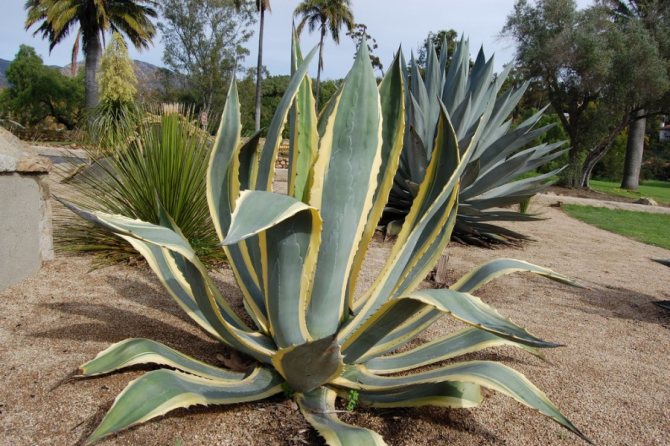

The climatic conditions of growth predetermined the appearance of the plant. Agaves have no stem. And only some of them have a short stalk.
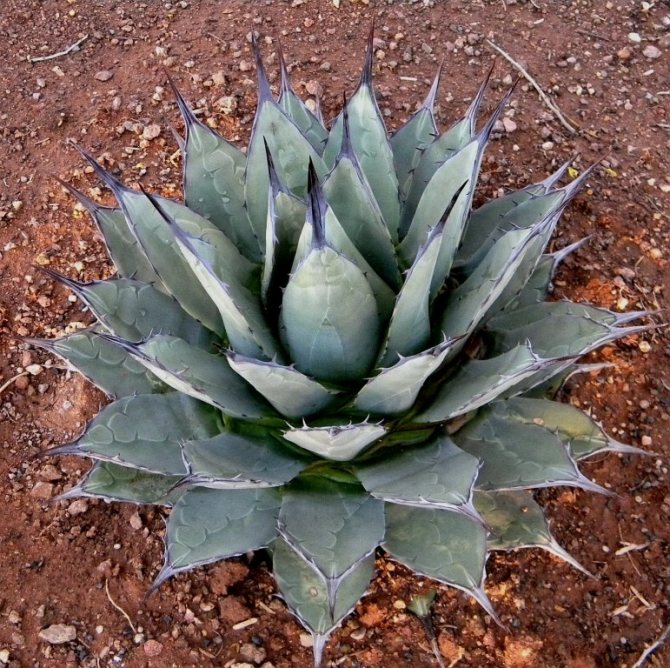

Dense, fleshy leaves, pointed at the top, collected in a rosette. Their edges are decorated with straight or curved spines. Each leaf contains a large supply of liquid to help the plant survive drought. In the wild, you can find specimens reaching a diameter of 3 m.
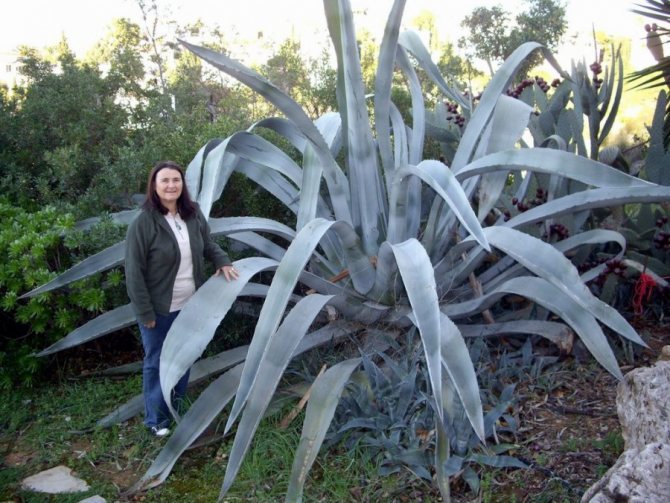

The leaves are colored green, silvery, bluish-green. In some views, there is a pattern in the form of white and yellow stripes. The leaf plate is covered with a waxy coating.
In their natural environment, almost all agaves bloom, which cannot be said about the ornamental varieties of the plant. Once every 15-20 years, agave forms a vertical peduncle, the length of which can be 10-15 m.
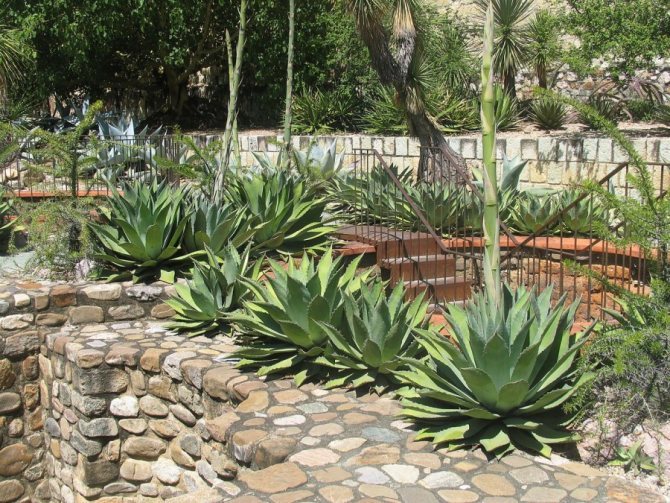

Its top is decorated with many small inflorescences of white, light brown and yellow shades. Flowers are collected in separate bunches, they open gradually over several months.
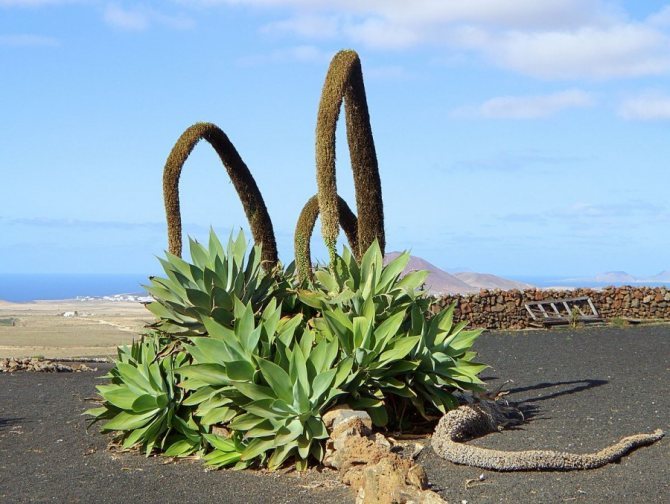

Fading away, the mother plant dies off, leaving behind young shoots. When using agave as a tub culture, flowering occurs in 20-30 years of growth.
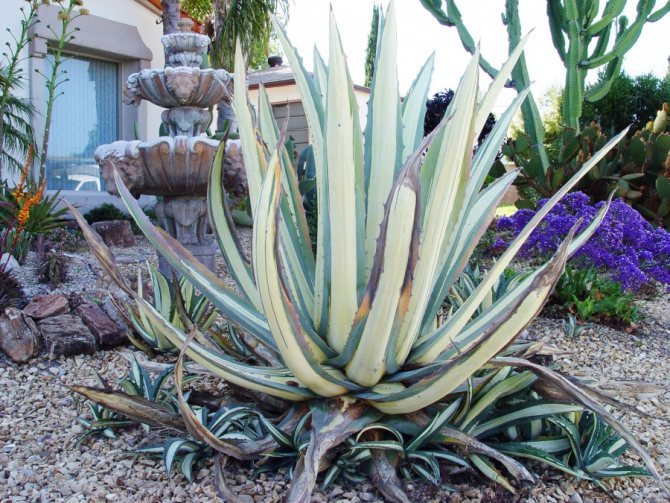

The characteristic features are shown in the photo of the agave in our gallery.
Homeland of origin of the agave plant
Agave (Agave) belongs to the Asparagus family.
Other names: Century plant - century plant (agave), American aloe-American aloe, American sisal - American sisal.
The birthplace of the agave plant is Mexico, Central America, the USA and the Caribbean islands.
The popular popular name agave was given to agave for the delusion that it blooms once every hundred years. American aloe agave is called for the external similarity of these plants, as well as for the same widespread use of agaves in the American continent as aloe in the Old World.
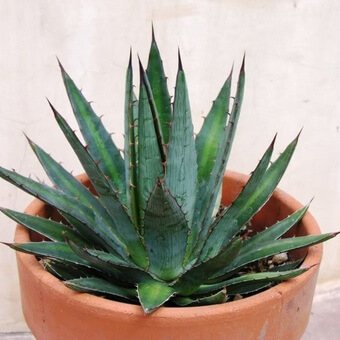

In ancient Mexico, agave played a leading role in economic life, culture, even religion. The well-being of the Aztecs depended on the agave harvest. In their legends, the goddess Magway, that is, the agave, protected pregnant women from becoming wild animals. To do this, it was necessary for a certain time to put the leaves of the miraculous agave on the face of the pregnant woman.
This plant is so widespread in Mexico that the country got its name in honor of the agave - “the place of the agave”.
Agave plantations are cultivated in Mexico, where the plant is not allowed to bloom. When a young bud becomes visible in the middle of the rosette, it is excised. In the formed fossa, sweet juice is collected, which was supposed to go to the formation of the stem, flowers and fruits.
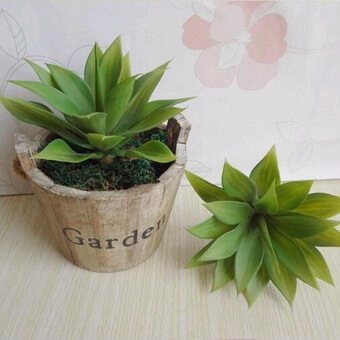

This juice contains 10% sugars and in Spanish is called aquamiel, which means "sweet water" or "honey water". This juice is scooped out 3 times a day. The plant is able to produce sap for 8 to 10 months, until the leaves are completely dry. For the entire period from one plant alone, you can collect up to 1000 liters of juice.
Agave reduces the number of pathogens in the air by 69%, as well as fungal spores.
The sap of the plant is allergic and can also cause contact dermatitis. In the scientific literature, there are cases of the appearance of purple dermatitis, similar to purple vasculitis, on the legs of people a few hours after cutting down large plants of American agave, that is, due to contact of agave juice with the skin. Damage to small blood vessels occurs due to exposure to calcium oxalate crystals and saponins. Treatment is carried out by taking antihistamines and applying saline compresses to the affected areas. Systemic symptoms disappear within a day, and after 7-10 days, skin manifestations also decrease.

